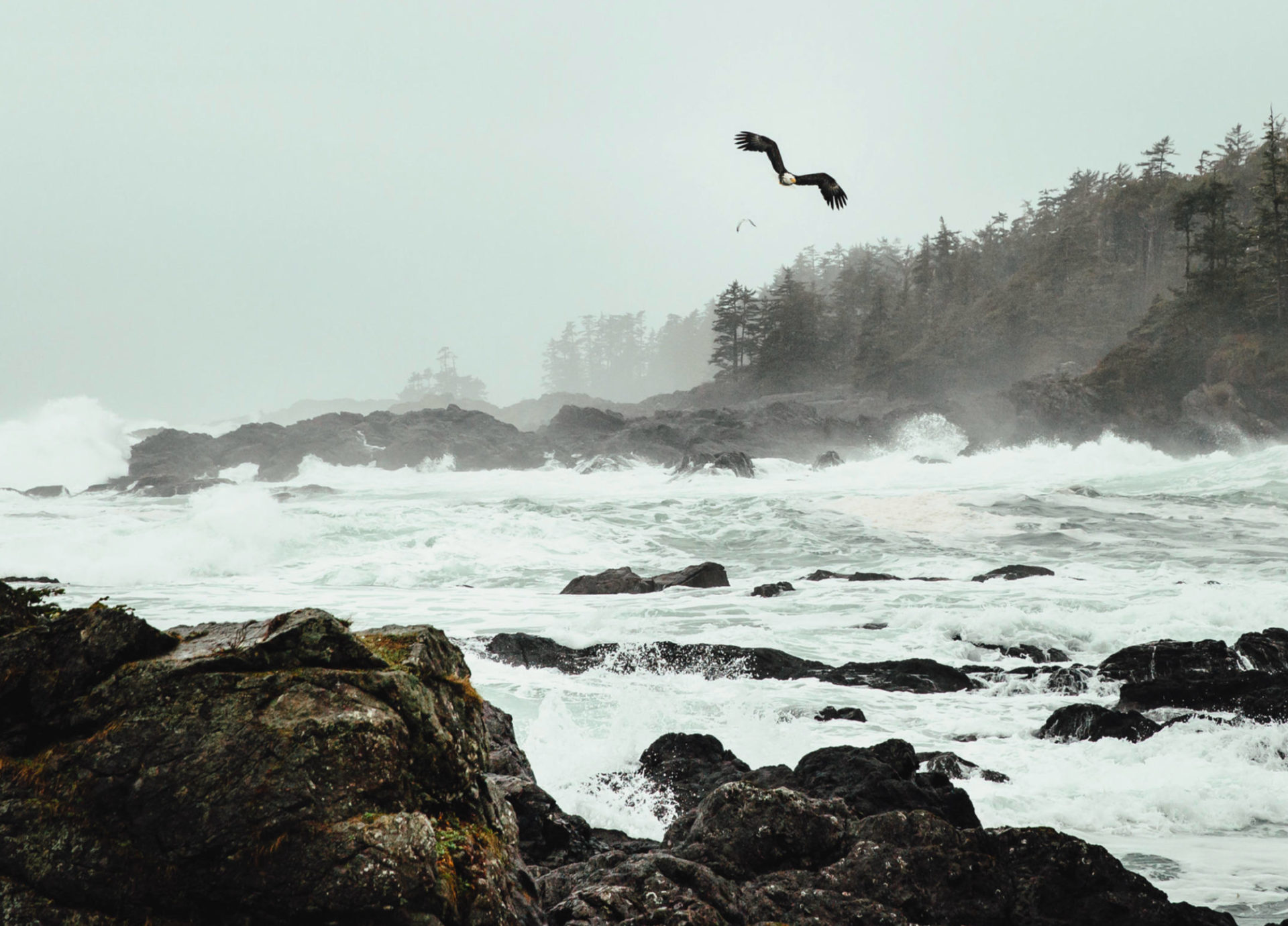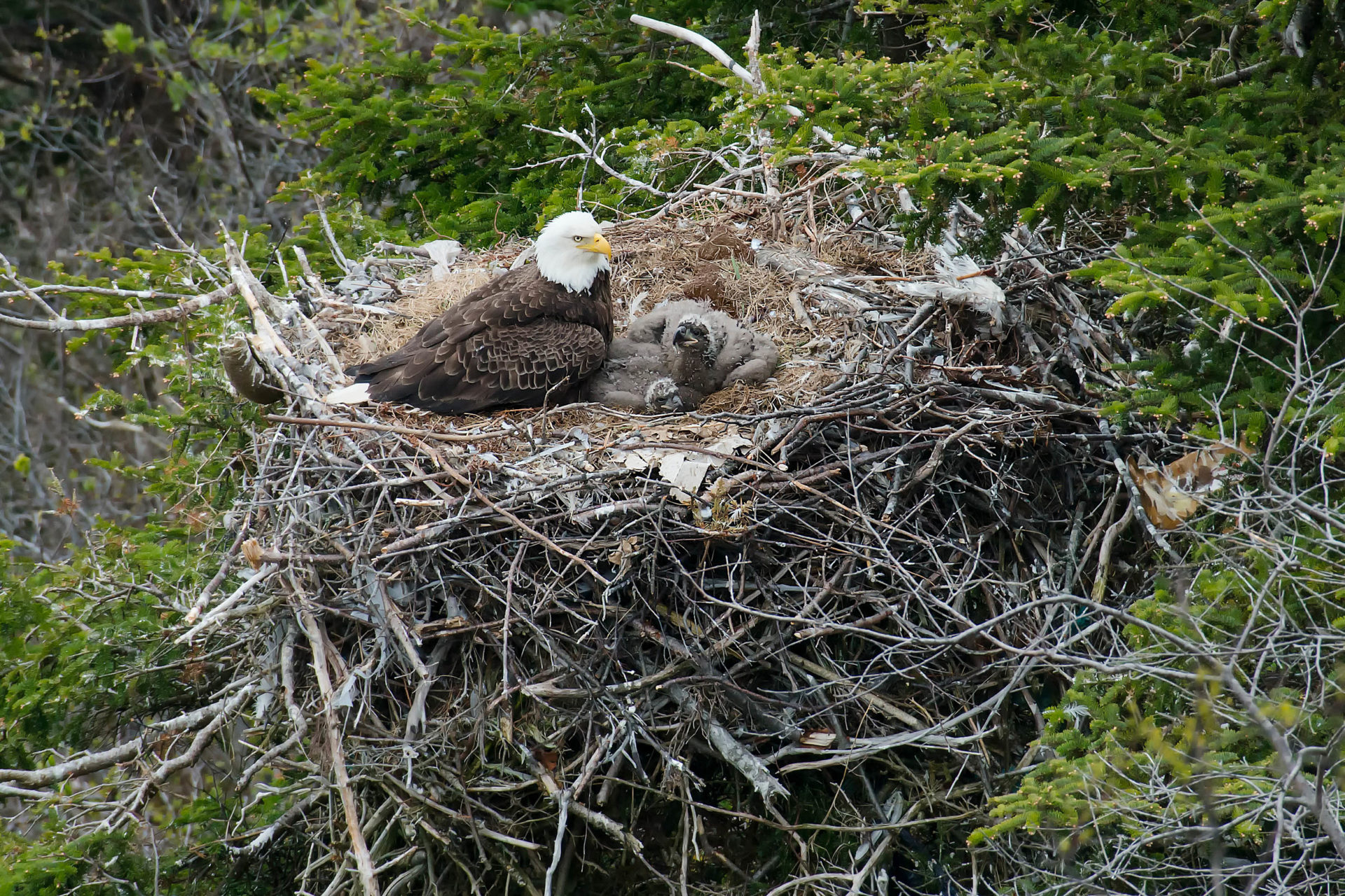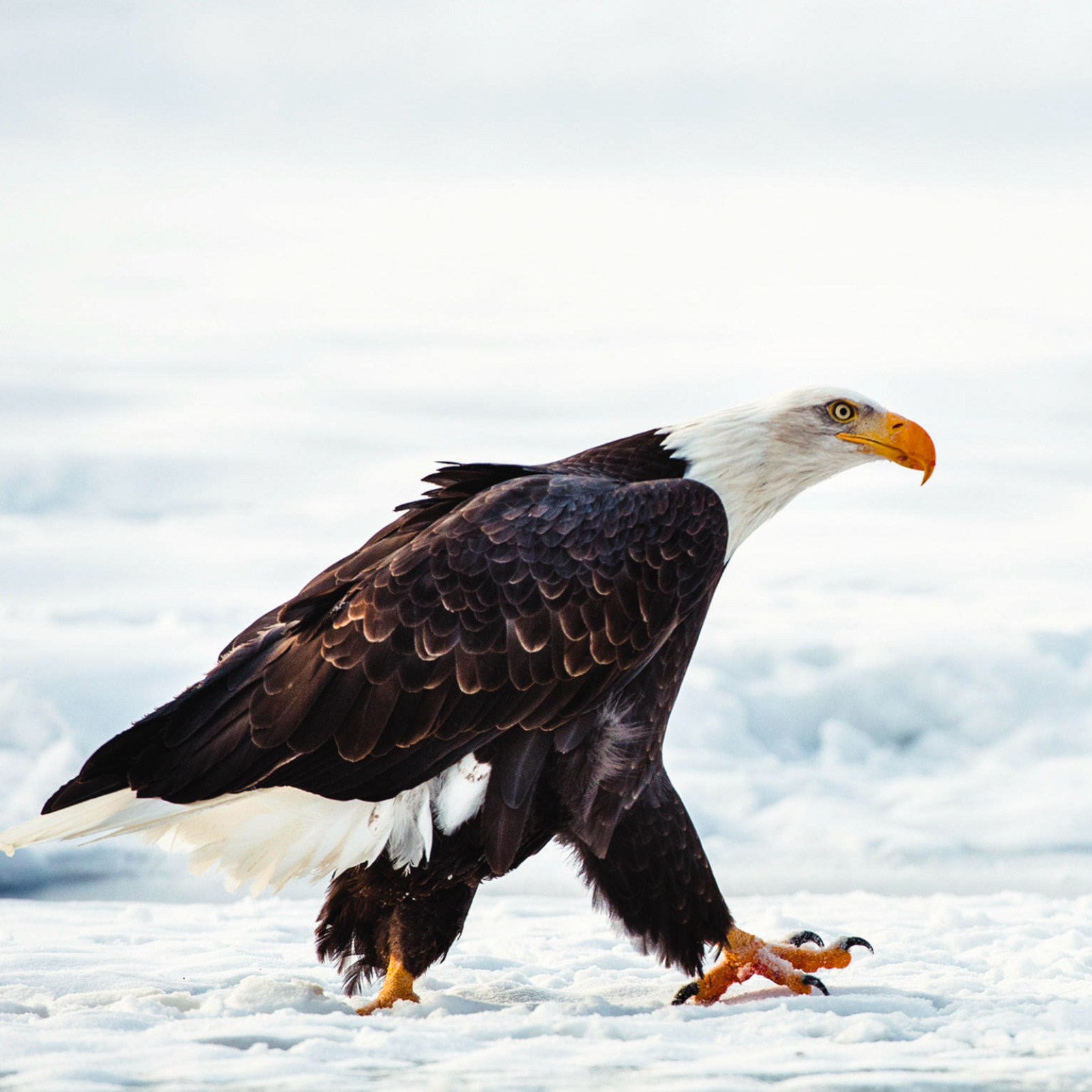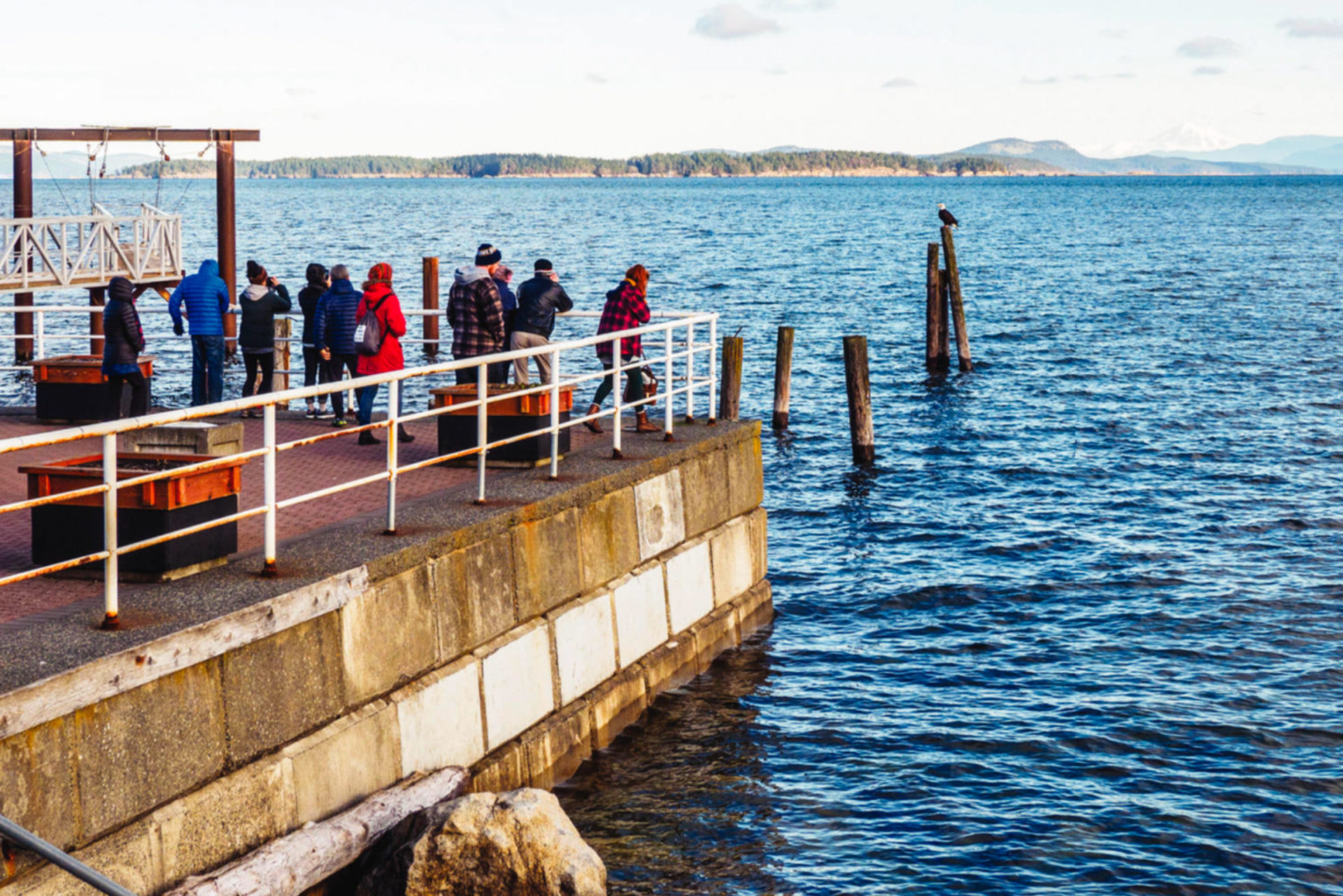One afternoon, I watched a bald eagle engaged in a wild dance with a glaucous-winged gull. The eagle was on the hunt and the gull was doing its best to elude the aggressor by rapidly changing directions. But the eagle’s powerful wings and keen eyes easily followed the gull’s evasive moves. Eventually, the exhausted and confused gull landed in Ross Bay. It was a fatal error. The eagle pounced with its powerful talons, plucked its prey from the water then landed on shoreside rocks. For the next hour, its hooked beak tore the feathers from the gull and devoured its flesh, encircled by a group of immobile crows, appearing traumatized but perhaps hoping to catch a few leftover scraps. Nature, red in tooth and claw.

This bloody event was my introduction to the power and mystique of this apex predator (Haliaeetus leucocephalus, the first term means “sea eagle,” the second “white head”), whose skill, agility and strength has given it an almost mythical aura. When I moved to British Columbia 30 years ago, having spent most of my life in cities, I’d never seen an eagle. Seeing one in action was both fascinating and unsettling.
A few months after the bald eagle’s hunt, we sailed north in our small sailboat and I indulged my growing fascination with bald eagles to carry out a private eagle count on the way. Binoculars in hand, I’d scour the tall trees for a glimpse of whiteness in the dark foliage. I learned that eagles perched near or at the top of trees, surveying their kingdom with seeming disdain. I stopped when I’d counted 68 birds. I learned later that among the 59 eagle species around the world, the bald eagle is by far the most common in our province, with a population in BC of about 20,000, second only to Alaska’s count of about 70,000. Due to our relatively mild climate, eagles don’t migrate and tend to live near oceans or streams—especially if fish is abundant.
Anchored in Bull Harbour, on Hope Island at Vancouver island’s north end, I received another eagle lesson. The eagle talk—often called chittering—was loud and continuous. Some 25 eagles occupied the trees around the isolated inlet, some with the characteristic sleek white heads and tails, others looking a ruffled, untidy brown. We’d chanced upon a colony where eagle parents were instructing their offspring to fly and hunt. Sometimes the youngsters took off, swooped over the water and then returned to their tree perches, while their parents chittered on.
Eagles, who usually live up to 20 to 25 years in the wild, mate for life and both parents are involved in raising their young. Eagle nests are large and round, built of twigs and small branches and lined with grasses and mosses. The same eagle couple will occupy a nest year after year. After the female lays up to three eggs, she covers them with her body and huge wings (the wingspan measures between 182 centimetres to 229 centimetres or six to 7.5 feet) while her partner brings her food. It usually takes 37 days of incubation before the hatchlings pick their way through the shells. Newly born, the eaglets are covered with down and resemble small furballs. They eat half their body weight each day, keeping both parents busy finding enough food for their ever-open beaks. Fish is the favourite food, but rabbits and squirrels can also make up part of the diet. Survival is precarious for newborn eagles, with only 20 to 30 percent reaching adulthood. Although eagles are a top predator who are rarely attacked, their offspring is fair game. Raccoons, ravens, cougars, gulls and owls can help themselves to fledglings when both parents are away hunting food. Accidents, food scarcity, falls from the nest and siblicide, where a bigger nestling kills a sibling, all contribute to early death. For those who survive, feathers emerge quickly and by the time the newborns are eight weeks old, they’re nearing their full weight and start branch hopping to learn balance and strengthen their flight muscles in a prelude to flying.

They need to survive four to five years to full maturity before their heads and tails carry the characteristic white feathers that gives them their name. (“Bald” is an adaptation of “balde,” an Old English word meaning “white.”) Their reproductive cycle begins when they reach that stage.
Female bald eagles are about 20 percent larger than the males, perhaps to shield eggs and newborns, and can weigh up to 4.5 kilograms (10 pounds). Like most birds, eagles’ bones are hollow and pneumatic, which contributes to their ability to soar; feathers make up most of their weight.
Most people admire the way eagles fly. They can soar up to three kilometres (10,000 feet) high, which has inspired the phrase “soaring on the wings of eagles.” They are masters of playing air currents, thermals and updrafts and can fly for hours with only an occasional flapping of their wings, thereby conserving energy and covering huge distances.
We all know the common term “eagle eye.” That honours the bird for its phenomenal eyesight. Their eyes, which turn yellow in maturity, are roughly the same size as human eyes, but eagle eyes contain a much greater concentration of rods and cones. It’s estimated they can see three or four times better than humans, and they can spot a fish swimming near the surface, or a rabbit hopping in a field from a kilometre or more away.
Eagle eyes have evolved in wondrous ways. To protect their eyes, eagles can close their nictitating membrane, also called a haw. A nictitating membrane is defined as “a transparent or translucent third eyelid… that can be drawn across the eye for protection and to moisten it while maintaining vision…” With the membrane lowered, eagles can look directly at the sun even when detecting their prey.
Eagles also sport a bony ridge above their eyes—the supra-orbital ridge—that is further covered by white eyebrow feathers. This feature screens their eyes from the sun’s bright glare.
Eagle feet have evolved into engines of efficiency. Their claws lock onto tree branches so the eagle can just sit or sleep comfortably. The feet lack fur and are covered with a bumpy, textured skin that helps grip slippery fish. The grasping three front toes are placed before a single back toe, called a “hallux.” We might compare the back toe to a human opposing thumb, allowing for a circular clench. Each toe has a talon or claw so hard and sharp they can penetrate fish skin, bird feathers and furry skin instantly. Their length can range from five centimetres in a large female, to 3.25 centimetres in a smaller male. When attacking prey, the eagle’s leg muscles contract, which tightens the talons in a vice-like grip. When l saw the eagle slam down on the gull on Ross Bay, its talons killed the gull at once by penetrating into its vital organs.
Sometimes, when a fish is too heavy to haul into the sky, an eagle will swim holding the load with those mighty feet and talons. Flapping its wings at water level, the raptor uses the surface to drag its prey to shore where it can lunch at leisure.
I’ve heard people say they dislike gulls and crows because these birds are scavengers. Eagles, although they are certainly opportunistic scavengers, seem generally to be forgiven for eating dead animals or filching from others. They will congregate in landfills and rummage around in the garbage. They will chase other raptors—including other eagles—forcing them to drop their prey or scare them away from a feed.

It’s easy to forget that eagles, like other wild animals, must hunt and forage each day to stay alive. It’s a full-time job. (Lest we become too disdainful of scavengers, we should remember that most humans scavenge too, obtaining their animal protein under plastic in the supermarket.) It takes enormous amounts of energy for eagles to hunt, thus finding food easily and minimizing all that effort is appealing. That is one of the reasons why, in the fall, when salmon spawn and die in BC’s rivers, eagles congregate and feast on the carcasses. They not only fatten up for the coming winter, but their razor-sharp beaks tearing apart the dead fish add to the continual cycle of life.
As the Book of Eagles explains, “the eagles fertilize the river with the bits and pieces of the remaining carcass… [that] serve as fertilizer for the algae and streamside plants that bloom in the spring. Insects eat the algae and other plants. Young salmon eat the insects and grow to complete their role in the endlessly recurring cycle of birth, nourishment and death.”
The 1960s saw enormous growth in the use of the insecticide DDT. It was first developed to combat insect-carried diseases like malaria and typhus and then extended to control crop-destroying insects. But DDT use had serious toxic side effects, among them the thinning of eagle egg shells. The fragile eggshells would break, killing the premature embryos, and eagles became an endangered species in the US. After the pesticide was banned in 1972, eagles there have made a comeback. The eagle population of BC was less affected, perhaps because the huge forested areas of the province were not treated with DDT.
Eagles continue to fascinate people and they flock to view the substantial BC fall gatherings of these majestic raptors. Although l no longer count how many I can see during a coastal voyage, I still grab my binocs when they fly by because as poet William Blake wrote, “When thou seest an eagle, thou seest a portion of genius. Lift up thy head.”

Eagle Heraldry
Eagles are both the king of birds and the bird of kings. Their courage, swiftness and strength have been portrayed in the heraldry and crests of emperors, kings and armies for thousands of years. In ancient Rome, for example, the aquila—the Latin word that evolved into the English eagle—decorated the standards Roman legions carried into battle.
Wikipedia tells us that “The earliest known use of the eagle… is found in the Great Seal of Leopold IV of Austria, the symbol of the Habsburg dynasty and its emblem is featured in the double eagle mosaics of Vienna’s St. Stephen’s Cathedral’s roof. In 1782, the US made the eagle its national symbol of freedom and depicts the bird in the presidential seal and in all manner of political and military entities. Many countries, provinces and cities continue to feature an eagle in their flags.
The spiritual aspects of eagles are revealed in Indigenous tales informing us that as eagles fly higher than any other bird, they carry messages to the Creator. Images of eagles are seen in totem poles, masks, drums and headdresses: gifts of eagle feathers symbolize the giver’s respect for the recipient. The Bible states that “those who hope in the Lord will… soar on wings like eagles.”
Best Places for Eagle Viewing
Squamish: Eagle Run Viewing Shelter at 41015 Government Road in Brackendale. It offers an eagle and salmon interpretive display. Most eagles appear in fall and winter.
https://www.exploresquamish.com/explore/eagle-viewing
Harrison Mills: Claims to be home to the largest concentration of bald eagles in the world that feast on the Fraser River’s spawning salmon.
http://tourismharrisonmills.com/harrison-mills/eagles-and-wildlife/
South Delta: Boundary Bay Regional Park hosts many species of migrating birds and eagles.
http://www.metrovancouver.org/services/parks/parks-greenways-reserves/boundary-bay-regional-park
Victoria: Goldstream Park. Eagles swoop in to fatten up for the winter when the chum salmon spawn.
https://bcparks.ca/explore/parkpgs/goldstream/
Duncan/Cowichan: The non-profit Raptors specializes in training captive-bred birds of prey and educating the public. It’s an easy way to see raptors up close.
Sources for Eagle Info
https://www.squamishenvironment.ca/programs/eaglewatch/understanding-bald-eagles/
McCartie, Gary. The Book of Eagles. Published by Beautiful British Columbia Magazine and the Nature Conservancy of Canada. 1995.

